Plants are useful to our lives in so many ways. From a commercial, infrastructural, or even aesthetic standpoint, we can benefit from many plants of all shapes and sizes.
Plants can provide our homes with shade and help the environment by regulating the surrounding temperature. Trees can be turned into precious timber and used for construction and housing purposes.
Meanwhile, beautiful plants with unique flowers and foliage are best grown for ornamental purposes.
Don’t be surprised to know that you can also use plants for security purposes. Having a bunch of thick, thorny bushes planted around the perimeter of your house can help fend off wild animals or, worse, burglars.
What kind of thorny bushes are suitable to be grown around your house?
Here are thirteen great species that you should keep an eye for:
Table of Contents
1. Common Holly (Ilex aquifolium)

These thorny shrubs aren’t new to people who love evergreen plants. Common holly also goes by other names such as European holly, English holly, and Christmas holly.
Common hollies are native to Europe, southwest Asia, and northwest Africa.
Common hollies are easy to recognize. They have glossy green, thorny leaves, tan to yellow branches, and striking red berries that attract birds and other animals.
At maturity, these shrubs can grow up to ten feet tall.
Common holly bushes thrive in USDA hardiness zones 5 to 8. If you’re planting these bushes around your house, be sure to provide them with enough sunlight, a good amount of water, and well-drained soil.
2. Japanese Barberry (Berberis thunbergii)
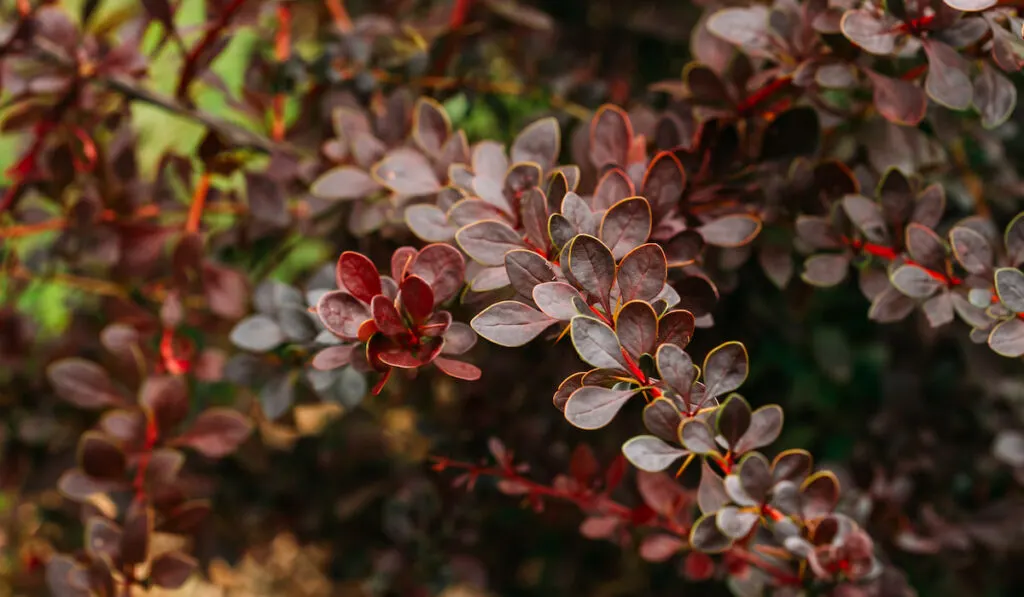
If you think these shrubs look harmless from afar, think again and take a closer look.
Japanese barberries are full of long and tiny prickly thorns on their branches and stems.
These small to medium-sized bushes typically grow in USDA hardiness zone 4, reaching a height between 2 and 8 feet.
Originating from Japan and eastern Asia, these plants can be distinguished by their green and bluish-green leaves, yellow flowers, and clusters of red fruits or berries. They can tolerate partial or full sun and soil with different acidities.
Like most plants, Japanese barberry will grow healthily in well-drained soil. Japanese barberries are quite competitive. These shrubs are considered an invasive species and can dominate their surroundings, choking out the native vegetation and creating monocultures.
3. Common Gorse (Ulex europaeus)
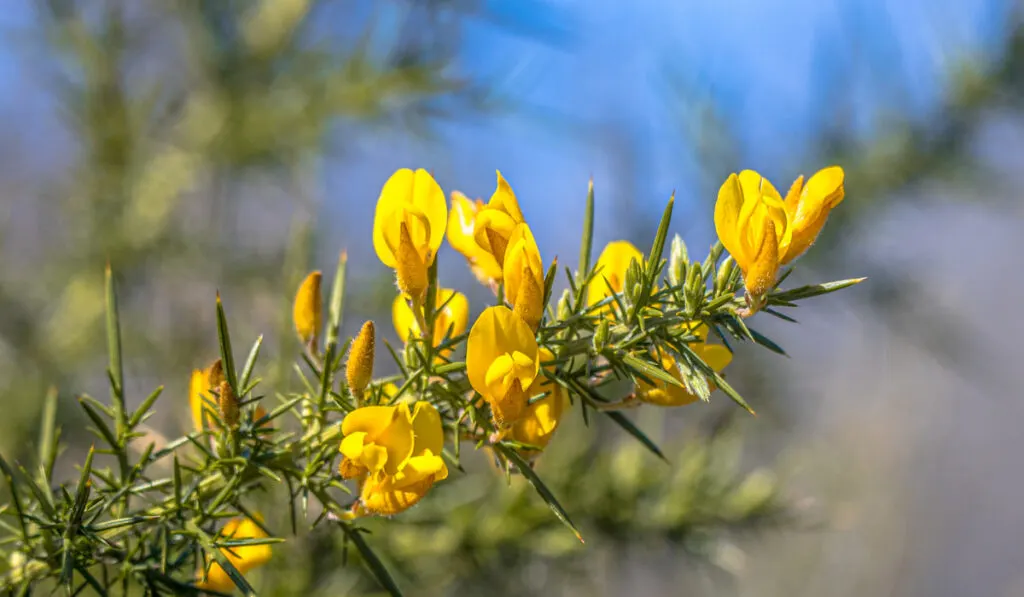
These thorny bushes are also known as whin or furze.
Common gorse originated from regions in northwest Africa and Western Europe. In the United States, these plants can be found in arid areas such as Oregon, Hawaii, and California.
Common gorses grow between 7 and 10 feet tall in the hardiness zones 6 to 10. They have tiny, elongated leaves, yellow flowers, and thorny or spiny branched shoots.
Being a hardy species, these bushes can thrive in arid and poor environments. However, they are considered an invasive species and can overgrow and take up space or nutrients from the environment they grow in.
Common gorses burn easily when they are dead and dried. Hence, they are considered fire hazard plants.
4. Prickly Ash (Zanthoxylum americanum)
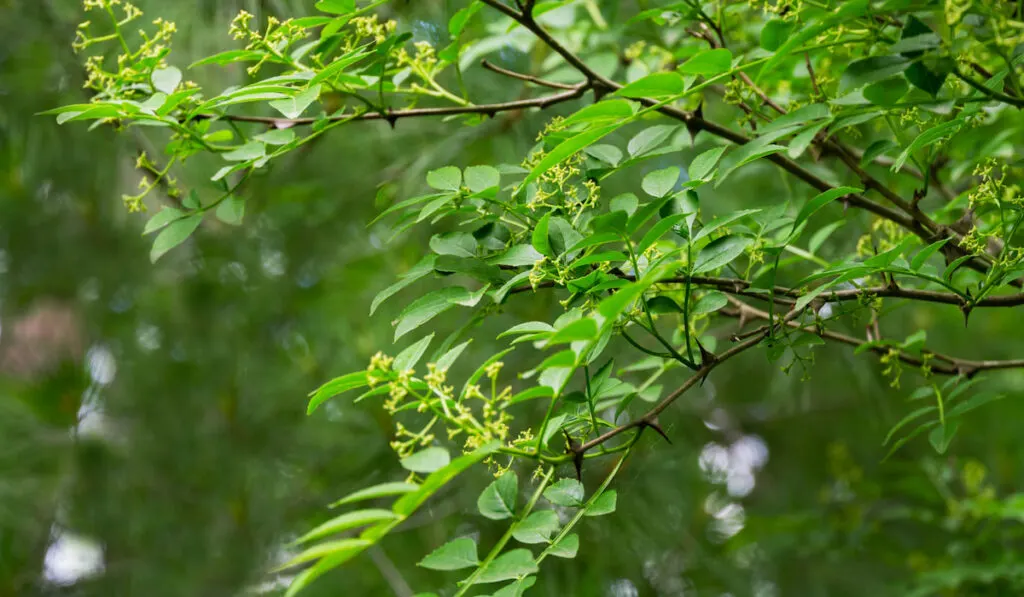
Prickly ash shrubs are native to North America, particularly the United States and Canada. They are also called yellow wood trees, suterberry, and toothache trees.
These medium to large-sized shrubs can grow up to 20 feet tall with a spread of 10 to 15 feet. They can be characterized by their glossy dark green foliage, reddish-brown berries, thorny stems and branches, and yellow flowers that bloom in the spring.
These plants also produce aromatic scents that attract insect pollinators such as bees.
Prickly ash shrubs thrive in the USDA hardiness zone 3 to 7.
Although they are considered hardy, these plants grow better in moist, well-drained soil and under partial or full sun. They also can tolerate soils with different pH levels.
5. Sea Buckthorn (Hippophae rhamnoides)
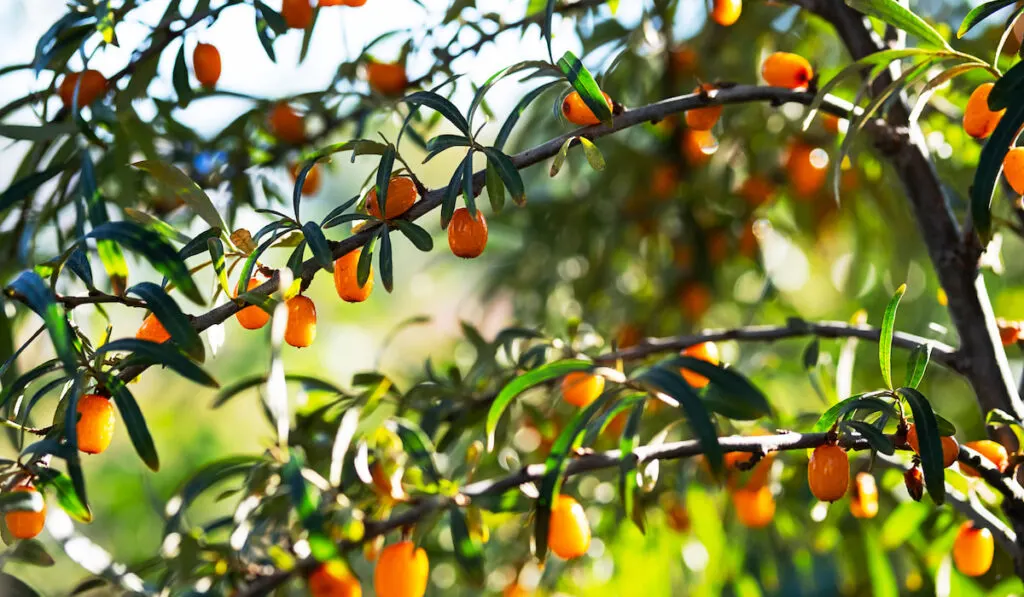
You can find these prickly shrubs growing in their native habitat in Europe and Central Asia. They are also known as sallow thorns, seaberry, and sandthorns.
Sea buckthorns possess small, elongated green leaves, thorny stems, and bright yellow fruits. Their nutritious fruits can be processed into healthy drinks that are rich in vitamins A and E, protein, and other organic compounds.
These plants generally grow between 8 and 20 feet tall and spread around 60 feet wide. They thrive in USDA hardiness zone 3 and prefer being exposed to full sun.
As long as the soil is well-drained, sea buckthorns can tolerate any level of acidity.
6. Fuchsia-Flowered Gooseberry (Ribes speciosum)

In the United States, these shrubs can be commonly found in their native habitats such as Baja and central and southern California.
Fuchsia-flowered gooseberries are unique-looking plants with red, bell-shaped, or tube-shaped flowers hanging from their branches.
These shrubs also have glossy green leaves and stems equipped with long, sharp thorns.
They generally grow between 6 and 10 feet tall and spread between 3 to 8 feet wide. Fuchsia-flowered gooseberries also produce reddish-orange fruits in a group of four to 10.
Being a hardy species, fuchsia-flowered gooseberries can tolerate partial or full sun and arid or dry environments. However, they still prefer moist soil with proper drainage and neutral acidity.
7. Holly-leaved Barberry (Mahonia aquifolium)
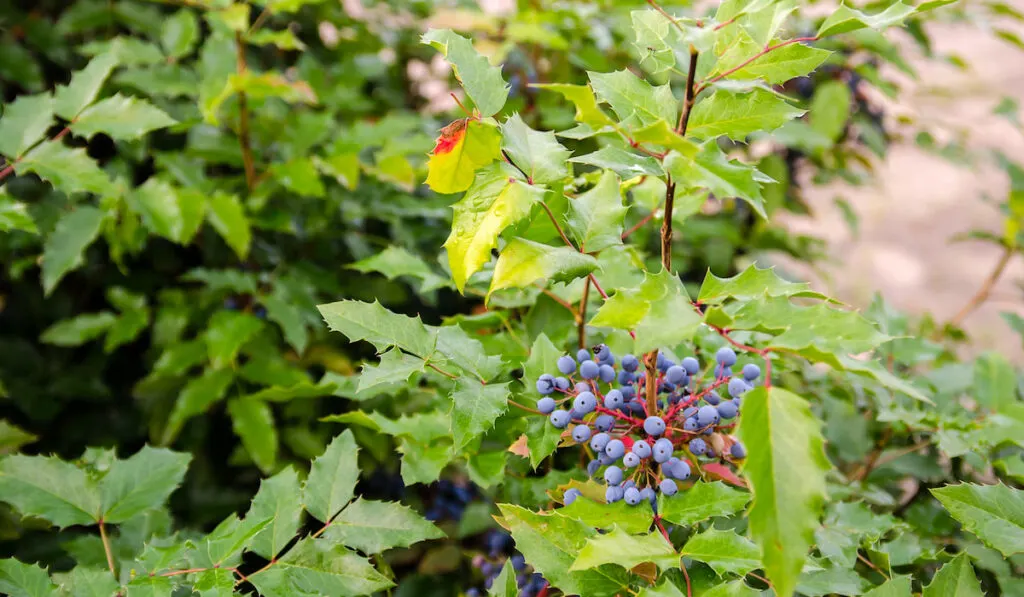
Holly-leaved barberry shrubs or Oregon grapes are native to North and Central America, Asia, and the Himalayas. In the United States, these plants are crowned as the state flower of Oregon.
These small to medium-size shrubs typically grow between 3 and 6 feet tall with a spread between 2 and 5 feet. They can be recognized by their glossy and thorny dark green leaves, reddish-brown stems, and dark blue berries that mature in late summer.
Holly-leaved barberries also produce scented yellow flowers that attract many pollinators.
These evergreen shrubs thrive in USDA hardiness zones 5 to 8. They prefer moist, well-drained soil and can tolerate partial or full sun.
8. Firethorn (Pyracantha coccinea)

These thorny and fruitful shrubs originated in southeastern Europe and Southeast Asia.
They are easily distinguished by their oval-shaped green leaves, thorny branches, and clusters of brightly colored berries. The pulp from these berries is edible, but the seeds are poisonous and can’t be consumed.
Firethorns usually grow between 8 to 18 feet tall with an 8 to 18-foot spread.
They thrive in USDA hardiness zones 6 to 9 and can tolerate different levels of acidity in the soil. As long as the soil is also well-drained, firethorn can grow under partial or even full sun.
Being fast growers, these shrubs are considered invasive and are able to dominate all the resources available in their growing area. This will cause quite a competition for other plants to grow.
9. Devil’s Thorn (Tribulus terrestris)

Devil’s thorns are hardy and invasive shrubs that are native to Africa, southern Europe, Asia, Australia, and Central and South America. These trailing plants are also called cat’s head, bullhead, devil’s eyelashes, tackweed, puncture-vine, and goat’s head.
They can grow up to 3 feet tall and are able to withstand dry and arid environments. Devil’s thorns possess green pinnate leaves, hairy stems, and five-petaled yellow flowers that bloom in the spring.
What makes these annual plants unique is their thorny fruits with long spines or burs. Most of the time, these spines are capable of piercing through tires, shoes, clothes, or even injuring the skin of animals and humans.
10. Japanese Rose (Kerria japonica)
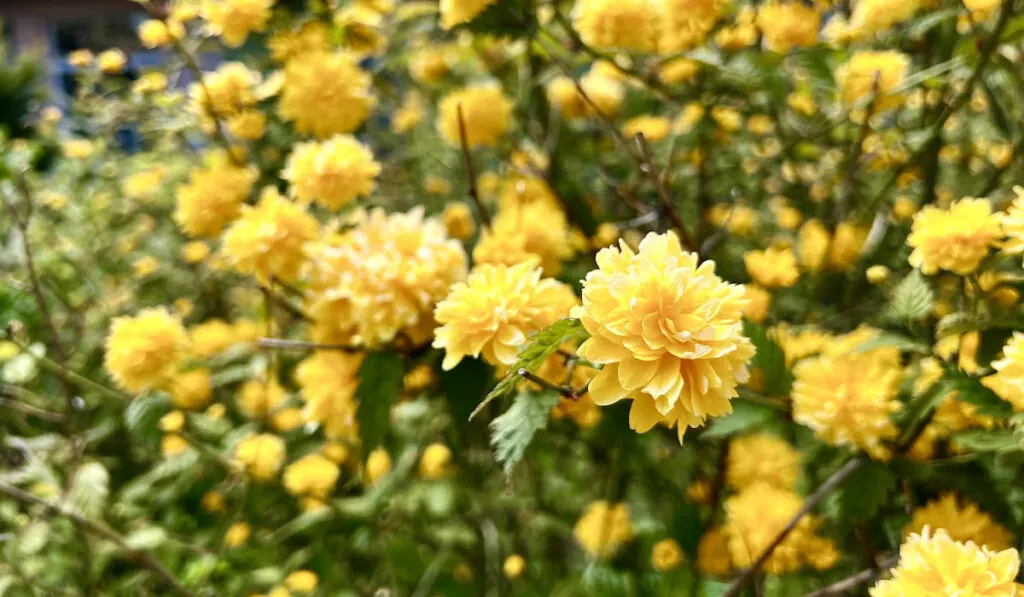
These flowering shrubs are native to regions in Asia, particularly Japan, southern Korea, and central and southern China.
Japanese roses are also known as Japanese Kerria, yellow rose of Texas, Jew’s mallow, bachelor’s buttons, and double-flowered Japanese rose.
Japanese roses typically grow between 8 and 10 feet tall with an 8- to 10-foot spread.
These plants are easily distinguished by their green leaves, green thorny stems, and yellow, pom-pom-like flowers that bloom in the spring.
They thrive in USDA hardiness zones 4 to 9 and are resistant to most pests or diseases. Japanese roses can tolerate partial or full sun. As long as the soil is well-drained, these plants can adapt to different levels of acidity.
11. Blackberry (Rubus fruticosus)
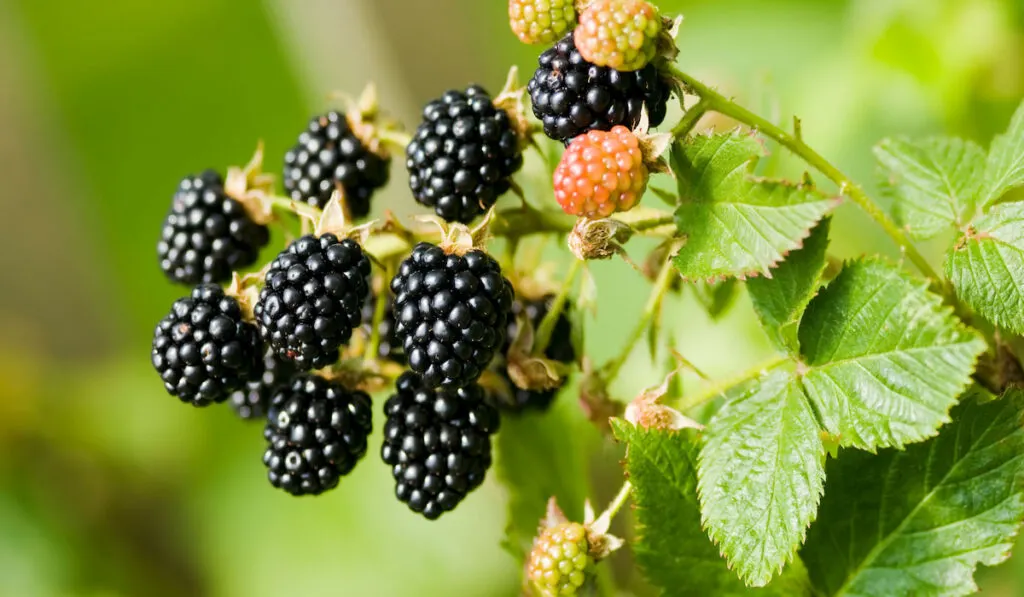
Blackberries are widely known for their nutritious black or purplish red fruits that are juicy and sweet. These berries also contain different types of vitamins, minerals, and beneficial organic compounds.
Speaking of the plants, blackberries can grow up to 20 feet tall. In some cases, under the right conditions, they can even grow as tall as 30 feet.
There are three types of blackberries such as trailing, erect, and semi-erect. Trailing blackberries are usually thornless, while erect and semi-erect varieties come in thorny and thornless versions.
Blackberries prefer moist, well-drained, and slightly acidic soil with enough exposure to full sun.
12. Agarita (Mahonia trifoliolata)
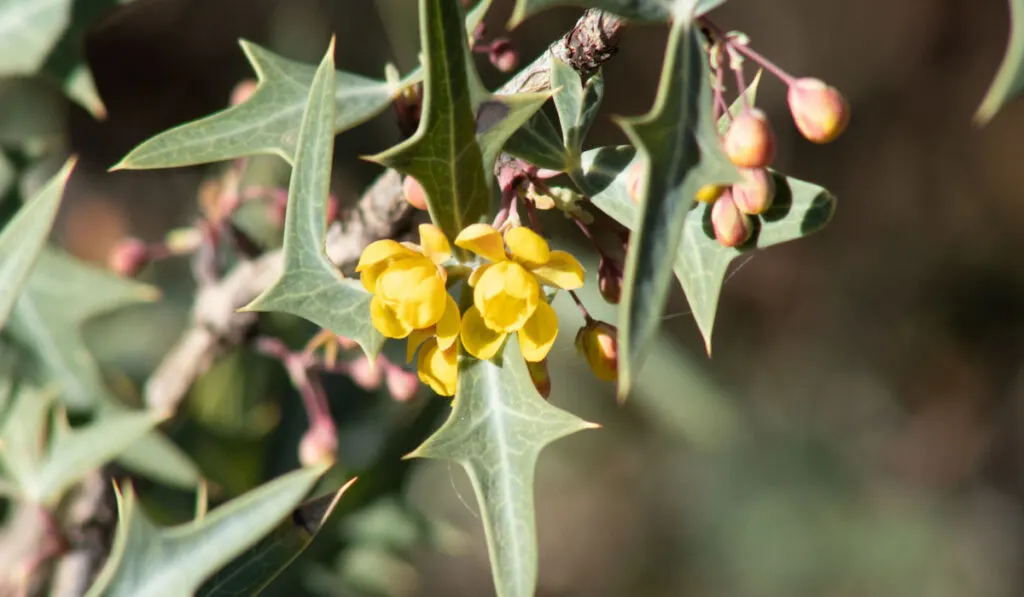
These thorny, dangerous-looking shrubs are native to North America, specifically in Texas, New Mexico, and Arizona. Agaritas are also called wild currant, Laredo Mahonia, and trifoliate barberry.
Agaritas have trifoliate stiff leaves that are equipped with pointy tips, edible red berries, and scented, cup-shaped flowers that come in yellow and bloom in the spring.
These hardy shrubs typically grow between 2 and 6 feet tall with the same spread.
Agaritas thrive in USDA hardiness zones 7 and 9 and can tolerate dry and arid environments.
If you’re living in hot regions, agaritas are the best choice for your house. They are low-maintenance, easy to grow, and possess the ability to withstand drought and scorching sun.
13. Japanese Quince (Chaenomeles japonica)
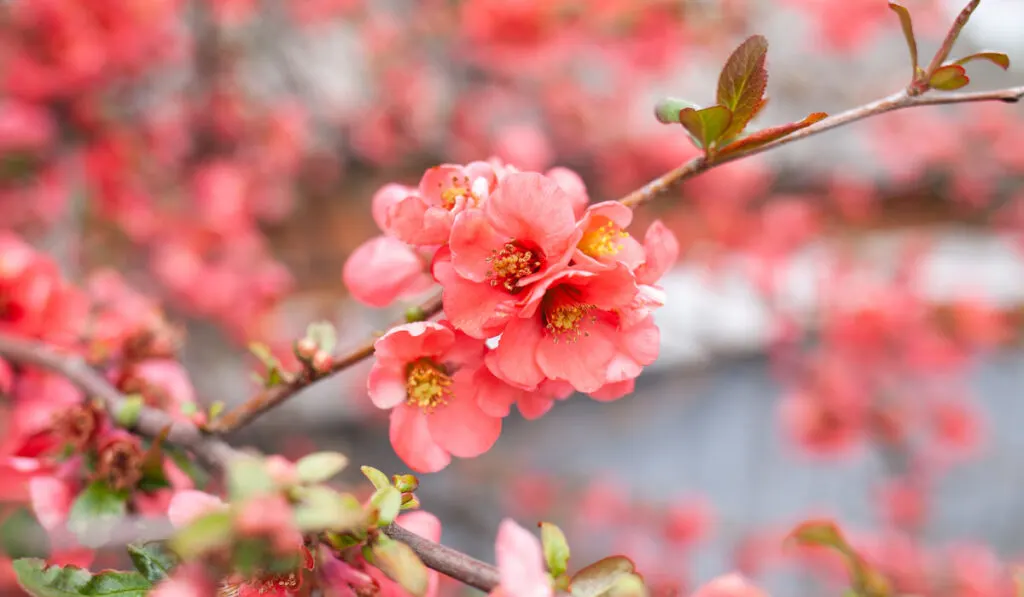
As their name implies, these deciduous shrubs are native to Japan. They usually grow between 2 and 3 feet tall and spread between 3 and 6 feet wide.
Japanese quince plants can be recognized by their grayish brown thorny stems, small green leaves, and scented pinkish or reddish-orange flowers that bloom in the spring.
These dense and low-growing shrubs prefer partial or full sun. They also love moist, well-drained soil and thrive in USDA hardiness zones 5 to 9.
Being a popular ornamental plant, Japanese quinces are considered low-maintenance and easy to grow. They don’t require much pruning, except for pest control and fungal management.
Final Thoughts
Having any of these thorny bushes planted around your house will certainly add an extra layer of protection that could ease your mind.
Not to mention, it is much stealthier to have these thorny bushes as a defense mechanism for your home because their prickly thorns are neatly hidden behind all the branches and foliage.
Having thorny plants is also cost-effective and much cheaper than having to build concrete walls or electric fences around your property. The only downside is that you’ll have to monitor your children and keep them away from these plants whenever they play around the house.
Resources
- https://www.thespruce.com/english-holly-plant-profile-5070521
- https://naturalresources.extension.iastate.edu/encyclopedia/japanese-barberry-invasive-species-profile
- https://www.wildlifetrusts.org/wildlife-explorer/trees-and-shrubs/common-gorse
- https://en.wikipedia.org/wiki/Ulex
- https://www.gardenia.net/plant/zanthoxylum-americanum
- http://www.omafra.gov.on.ca/english/crops/facts/seabuckthorn.htm
- https://calscape.org/Ribes-speciosum-(Fuchsiaflower-Gooseberry)
- https://www.gardenia.net/plant/mahonia-aquifolium-oregon-grape-holly
- https://en.wikipedia.org/wiki/Mahonia
- https://www.thespruce.com/firethorn-plant-care-guide-5202032
- https://en.wikipedia.org/wiki/Tribulus_terrestris
- https://www.gardenia.net/plant/mahonia-trifoliolata
- https://www.gardenia.net/plant/kerria-japonica-pleniflora-japanese-kerria
- https://plants.ces.ncsu.edu/plants/kerria-japonica/
- https://www.thespruce.com/japanese-quince-growing-profile-3957416
- https://www.gardeningknowhow.com/edible/fruits/blackberries/growing-blackberry-bushes.htm
